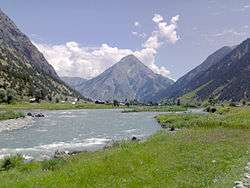Habba Khatoon

Habba Khatoon (1554–1609) was a 16th-century Kashmiri Muslim poet and ascetic, who is also known as 'Nightingale of Kashmir'. She was born in the small village of Chandhara near "Pampore" located outside Sempora in present Jammu and Kashmir state, and was known by the name Zoon (the Moon) because of her immense beauty until her marriage with Yusuf Shah Chak, who later became ruler of Kashmir, after which she was called Habba Khatoon. When her husband was captured by Mughal emperor Akbar taken away to Bengal (and later buried in Bihar) never to return, she became an ascetic.[1][2]Her tomb lies near Athwajan (English connotation -Handful of Rings) on the Jammu-Srinagar national highway.[1]
Biography
Habba Khatoon was a 16th-century Muslim poet from the village of Chandrahar of Kashmir. She was born in the small village ,Chendilora and was known under the name Zoon (the Moon) because of her immense beauty. After her marriage to Yusuf Shah Chak, who later became ruler of Kashmir, after which she was called Habba Khatoon.
Her songs are popular in Kashmir and she is almost a legendary figure in Kashmiri literary history. Perhaps the influence she has exerted over the popular imagination had much to do with the difficult life she had as a peasant girl who had received some basic education. Habba Khatoon was a peasant girl who, after a difficult first marriage which ended in divorce, married Kashmir's last independent King, Yousuf Shah Chak. When the Mughal King Akbar conquered Kashmir through deceit/treachery and exiled Yousuf Shah Chak, Habba Khatoon spent the rest of her life wandering across the Valley singing her songs. Even though there is some dispute about biography, the texts associated with her name are widely popular across Kashmir.
She grew up in the midst of the saffron fields and in the shade of the chinar trees. She was not raised as a typical peasant girl. She had learnt how to read and write from the village moulvi. At an early age her father married her to a peasant boy. But this illiterate peasant boy could not keep Zoon happy. He could not understand the longings of her heart. Just like Lal Ded, Zoon also was sad. Lalla became desperate and left her home. Zoon divorced her husband and started singing songs in Kashmiri.
Zoon used to sing in the shade of a chinar tree. One day Yusuph Shah Chak was out hunting that way on horseback. He happened to pass the place where Zoon was singing under the chinar tree. He heard her melancholic melodies, and went to look at her. He was stunned by her beauty. As soon as their eyes met, they fell in love. Later, Zoon and Yusuph Shah were married. She changed her name and became Habba Khatun.
Habba Khatun introduced "lol" to Kashmiri poetry, "lol" is more or less equivalent to the English 'lyric'. It conveys one brief thought.
Habba Khatun kept Yusuf Shah under her control. The couple was very contented, and Yousuf Shah became the ruler of Kashmir.
Their happiness did not last long. Akbar came into prominence in Delhi, and he called Yusuf Shah there. In 1579, Yusuph Shah was compelled to go to Delhi. In Delhi, Akbar arrested him via treachery. Earlier the Kashmiris had soundly defeated the Mughals consistently. He was kept in prison in Bihar. Poor Habba Khatun was separated from Yusuph Shah. The songs of Habba Khatun are full of the sorrow of separation. It is claimed that Habba Khatun introduced the 1ol into tho Kashmiri (language) After her came Arnimal who also sang mournful lyrics.
Habba Khatoon spent her last days singing her songs in the Valley, songs which are popular to this day. Even now you can see young Kashmiri singers turn to such popular lyrics as Mye ha kaer chey kit and Che Kamiu Sonei Myani. She has a profound presence in the oral tradition and is hailed as the last independent poet queen of Kashmir.
Honours
An underpass in Mughalpura, Lahore has been named after Habba Khatoon in her honour.
See also
References
- 1 2 "A grave mistake". The Tribune. June 3, 2000. Retrieved March 10, 2013.
- ↑ Kalla, p. 201
- Krishan Lal Kalla (1985). "19. Nightingale of Kashmr". The Literary Heritage of Kashmir. Mittal Publications.
- Habba Khatoon (1554–1609), Biography
- Kashmiri poets: Habba Khatoon
Further reading
- Wakhlu, S. N. (1994). Habba Khatoon: the nightingale of Kashmir. South Asia Publications. ISBN 8174330054.